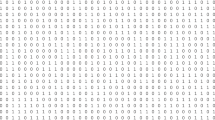Abstract
In this paper, a construction of ternary self-dual codes based on negacirculant matrices is given. As an application, we construct new extremal ternary self-dual codes of lengths 32, 40, 44, 52 and 56. Our approach regenerates all the known extremal self-dual codes of lengths 36, 48, 52 and 64. New extremal ternary quasi-twisted self-dual codes are also constructed.
Similar content being viewed by others
References
Bannai, E., Dougherty, S.T., Harada, M., Oura, M.: Type II codes, even unimodular lattices and invariant rings, IEEE Trans. Inform. Theory 45, 257–269 (1999)
Conway, J.H., Pless, V., Sloane, N.J.A.: Self-dual codes over GF(3) and GF(4) of length not exceeding 16, IEEE Trans. Inform. Theory 25, 312–322 (1979)
Conway, J.H., Sloane, N.J.A.: A note on optimal unimodular lattices, J. Number Theory 72, 357–362 (1998)
Conway, J.H., Sloane, N.J.A.: Sphere Packing, Lattices and Groups, 3rd ed., Springer, New York, 1999
Gaborit, P.: Construction of new extremal unimodular lattices. Eur. J. Combin. 25, 549–564 (2004)
Gaborit, P., Otmani, A.: Experimental constructions of self-dual codes, Finite Fields Appl. 9, 372–394 (2003)
Gulliver, T.A.: New optimal ternary linear codes, IEEE Trans. Inform. Theory 41, 1182–1185 (1995)
Gulliver, T.A., Harada, M.: Extremal self-dual codes over \({\mathbb{Z}}_6\) , \({\mathbb{Z}}_8\) and \({\mathbb{Z}}_{10}\) , AKCE Intern. J. Graphs Combin. 2, 11–24 (2005)
Harada, M.: New extremal ternary self-dual codes, Australas. J. Combin. 17, 133–145 (1998)
Harada, M.: An extremal ternary self-dual [28, 14, 9] code with a trivial automorphism group, Discrete Math. 239, 121–125 (2001)
Harada, M., Kitazume, M., Ozeki, M.: Ternary code construction of unimodular lattices and self-dual codes over \({\mathbb{Z}}_6\) , J. Algebraic Combin. 16, 209–223 (2002)
Horiguchi, N.: On the classification of the codes obtained by subtracting from the known ternary extremal self-dual codes (preprint)
Huffman, W.C.: On extremal self-dual ternary codes of lengths 28 to 40, IEEE Trans. Inform. Theory 38, 1395–1400 (1992)
Huffman, W.C.: On the classification and enumeration of self-dual codes, Finite Fields Appl. 11, 451–490 (2005)
Leon, J.S., Pless, V., Sloane, N.J.A.: On ternary self-dual codes of length 24. IEEE Trans. Inform. Theory 27, 176–180 (1981)
Mallows, C.L., Sloane, N.J.A.: An upper bound for self-dual codes, Inform. Control 22, 188–200 (1973)
Rains, E., Sloane, N.J.A.: Self-dual codes. In: Pless, V.S., Huffman, W.C. (eds.) Handbook of Coding Theory, pp. 177–294, Elsevier, Amsterdam, 1998
Sloane, N.J.A., Nebe, G.: Unimodular lattices, together with a table of the best such lattices. In A Catalogue of Lattices. Published electronically at http://www.research.att.com/~njas/lattices/
Author information
Authors and Affiliations
Corresponding author
Additional information
Supported by an NSERC discovery grant and a RTI grant.
Supported by an NSERC discovery grant and a RTI grant.
A summer student Chinook Scholarship is greatly appreciated.
Rights and permissions
About this article
Cite this article
Harada, M., Holzmann, W., Kharaghani, H. et al. Extremal Ternary Self-Dual Codes Constructed from Negacirculant Matrices. Graphs and Combinatorics 23, 401–417 (2007). https://doi.org/10.1007/s00373-007-0731-2
Received:
Accepted:
Issue Date:
DOI: https://doi.org/10.1007/s00373-007-0731-2




